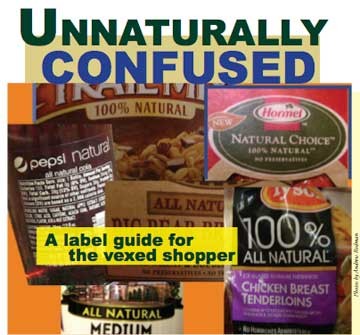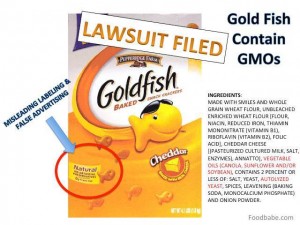A few months ago Starbucks was caught using “bug juice” in their half-caf-decaf, strawberry Frappuccino’s, also known in the food biz as carmine. Proponents of using carmine in foods say its ok and safe to use because it’s “natural”… a word in my opinion that is used way too often and frankly cheapens its original intent. Carmine is a food dye made from the extracts of dried bodies of the Coccus cacti bug, a member of the beetle family that can be found munching on cacti berries. The bug eats the red berries which turns the bug red when its crushed. I can hear the person who discovered this phenomena now, “Wow! let’s put this in food and we’ll make a fortune!” If you are in to eating bugs, then partake in carmine cuisine all you want, but if you are vegan (like me) or vegetarian, then I think a little disclosure is in order. Its all about labeling and doing so in a way that we can all understand, especially when it comes to what we are putting in our mouths.
The only reason manufacturers use carmine in their food and cosmetics is because it “looks pretty.” Starbucks has since stopped using carmine in their drinks, but there are many foods in your grocery stores that still contain it. Dannon and Yoplait come to mind and I know, because I read their labels. They both say they use real strawberries in their yogurts, so why do they need to add carmine? Its all about presentation. Some sales person in the bug selling industry must have convinced the “big wigs” in food sales… that even though their product tastes good… if they throw in some crushed bug juice, it will look awesome! And create MORE sales!
So when did carmine become popular with food manufacturers and how did they manage to slide this past our friends over at the FDA? I went to Wikipedia for the answer:
In January 2006, the United States Food and Drug Administration evaluated a proposal that would require food products containing carmine to list it by name on the ingredient label.[8] It was also announced that the FDA will separately review the ingredient labels of prescription drugs that contain colorings derived from carmine. A request from the Center for Science in the Public Interest urged that the FDA should require ingredient labels to explicitly state that carmine may cause severe allergic reactions and anaphylactic shock and that it is derived from insects was declined by the FDA.[9][10] Food industries were aggressively opposed to the idea of writing “insect-based” on the label, and the FDA agreed to allow “cochineal extract” or “carmine.”[11]
Although concerns over hazards from allergic reactions have been asserted,[12] the FDA has not banned the use of carmine and states it found no evidence of a “significant hazard” to the general population.[13] As with many chemical compounds, the dye may still pose an allergen hazard to a subset of the population.
Did you notice the part where food industries opposed labeling their ingredients as “insect-based”? They’re no dummies and know consumers will not be happy feeding bugs to their kids, at least not in the United States. For all of you arguing that a good deal of the world’s population already eats bugs… they do so, knowing they are eating bugs. They are not being deceived. But it does not stop there, carmine also called cochineal color can be listed as:
- color (120)
- color (E120)
- cochineal
- carmine (not to be confused with artificial colors carmoisine 122 or indigo carmine 132)
- cochineal carmine
- carminic acid
- color index (CI 75470)
There is a portion of the population that has severe allergic reactions to ingesting carmine as well, whether they are ingesting it or applying it to their skin, as in cosmetics.
Like I mentioned before the word natural is being used to describe too many things that are not natural at all. That’s because the word natural is not regulated like — organic. Farmers who want to be certified organic must jump through many costly hoops while food producers can slap the word natural on their label and pretty much get away with it. Consumers seem to be easily fooled (judging by some of my readers comments pertaining to some of my past posts regarding food safety). Consumers, or at least some seem to believe, if its sold in a grocery store or restaurant its safe to eat.
Luckily there are consumers who not only refuse to buy the deceptively labeled foods, but also are willing to take on the corporations by suing them. Last July, PepsiCo recently decided to stop calling their brand Naked Juice natural after paying out a 9 million dollars to settle a lawsuit. Before the lawsuit, Naked Juice claimed to be natural even though it contains synthetic and genetically modified ingredients. It will keep the same ingredients but drop the label.
A woman in Florida is taking Pepperidge Farms to court over their natural label on their Goldfish crackers. Her lawsuit, filed June 11 in federal court in Fort Lauderdale, seeks class-action status, new labels and at least $5 million in damages to reimburse Florida consumers who purchased the snack since June 2009, claiming the product violates Florida’s Deceptive and Unfair Trade Practices Act…. The FDA has not officially defined what “natural” means in terms of food labels, but its website says the agency “has not objected to the use of the term if the food does not contain added color, artificial flavors, or synthetic substances.”… according to the complaint, Leo purchased the snacks monthly from three stores in the suburban Boyton Beach area and “paid a premium” for them, believing that the “natural” label meant they contained no GMO ingredients.
Another lawsuit against the Gruma Corp. accuses the company of falsely labeling its Mission tortilla chips as “natural” even though they contain genetically engineered corn. U.S. District Judge Yvonne Gonzalez Rogers in Oakland, Calif., has decided to stay the litigation for six months and refer the question of “natural” labeling of genetically engineered ingredients to the FDA. Well, we all know what the FDA will say about that. Monsanto’s former top executive, Michael Taylor heads the FDA. He will stop using the word natural, to describe genetically modified foods the day I am crowned Miss America!
While labeling foods as natural may have started out to help consumers buy healthier alternatives to conventional brands, it has turned into yet another marketing tool. So as a word of caution… if you see the word natural on food you are thinking of buying, put the food item back and run like hell!



As someone who see labels everyday I agree with you Inge.
Some of the manufacturers are better than others with their facts and what they call things. But I’m always amazed to see some of the new names somebody comes up with to describe, in accurate but creative ways, what’s in them.
Cosmetics are an interesting mix sometimes, nail polish in particular. Some of the nutritional supplement labels are interesting too, especially when you know what all the listed ingredients are. I have both an unabridged dictionary and a CRC Chemistry Manual on my bookshelf because I need them both for spell-checking and still can’t get them all right.
A lot of the products I would never buy or use because I know what’s listed in their ingredients. I sometimes wonder how they can sell them, or make the claims they do for them, especially some of the nutritional and diet stuff.
Even the term organic has different meanings to different people in the business and I fear GMO will as well. Some of the other “certifications” I think are questionable too, but that’s just my humble opinion, sitting here setting type…
*The State of Washington has GMO Labeling and Connecticut either has it now or
will soon.
I thought Washington State has yet to vote on it and I Connecticut will put it into law when 4 more states join them…
Carl, I probably should buy a chemistry book too….brief anecdote… over a year ago I was shopping at Ralph’s and put a bottle of Kraft Ranch Dressing in my cart. A woman shopping near me came over and told me not to buy it… I asked why and she told me the ingredients are all chemicals…no real stuff in that bottle. I thought she was making that up, when she confessed she works as a chemist for Kraft…so I asked her why she works for a company that she doesn’t really believe in and she said she makes great money… Maybe she felt some guilt when she saw me buying her product. That was when I really got interested in finding out what’s hidden in our foods.
*Inge and Carl – start with this:
http://www.trueactivist.com/breakdown-of-gmo-labeling-laws-by-country-global-map/
This will definitely freak you out!
*Maine, New Hampshie, Connecticut and Washington are all in play:
Sadly, you are right….this is the reality:
http://www.occupy.com/article/initiative-522-washington-states-gmo-labeling-law-gaining-momentum
Ron,
None of that freaked me out. US agri-biz is the major exporter to the world in the GMO arena. The simpletons in this country and state seem hell bent on destruction sometimes with the way they vote, that isn’t a surprise to me at all.
I just got done doing the new labels for the entire Dr Bronners liquid soap line with the new NON-GMO labeling. As well a few weeks ago we redid the ones headed to Washington with the YES on 522 labels.
It’s one hell of a shame that CA voted as they did the last time around, I hope in WA they can see the forest for the trees.
You do the Dr. Bronner’s labels? I’m impressed. They are the model for many websites.
Carl, you work for Bronners soap? I am a customer since 1990s….liquid almond for me. I think the problem is this… people are not dropping dead after eating only one and do not understand that it adds up cumulatively over time and then one day BAM! YOUR IT! They do not connect the dots until its too late. I am optimistic that we will prevail in the end!